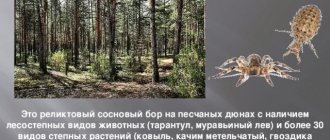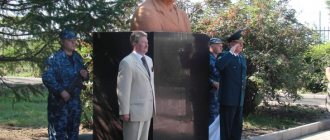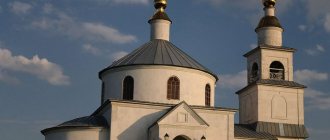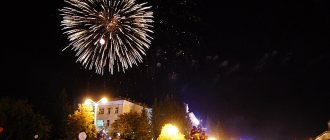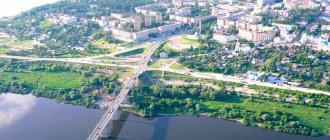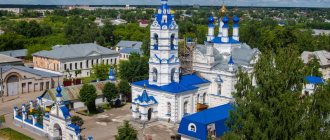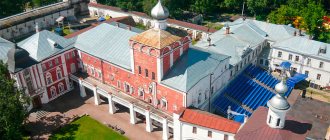The Kurgan region is located in the basin of the Tobol and Iset rivers in the Ural Federal District. There are many rivers and streams flowing through the region, and there are a large number of beautiful lakes, some of which contain healing mineral waters.
The Kurgan region does not have many historical attractions, but it is famous for its natural monuments of regional significance (84), zoological reserves (16) and simply beautiful places.
Dalmatian Assumption Monastery
The Dalmatian Assumption Monastery is one of the most famous and beautiful historical and religious monuments in the Kurgan region. The monastery was founded in 1644 by an elder named Dalmat. At first, the elder lived in a cave dug into the clay bank of the Iset, and by 1691 a monastery was already operating in this place, next to which a settlement arose.
The first stone building on the territory of the monastery - the three-altar Assumption Cathedral - was built from 1707 to 1720. At the same time, powerful stone walls with high towers were erected. During the history of its existence, the monastery was repeatedly attacked and destroyed - by Bashkirs, Tatars, Kalmyks, during the peasant uprising of the Dubinshchina, and then the Pugachevshchina.
Such famous people as A.S., Popov, radio inventor, traveler and writer K.D. studied at the Dalmatian Theological School. Nosilov, V.M. Florinsky, founder of Tomsk University. The monastery was also distinguished by the opening of the first girls’ school in 1861.
In 1928, like most other holy places, the Dalmatian monastery was closed, and its buildings in different years housed a school, a museum, a drama theater, an orphanage, a hospital during the war, and after the Second World War. Only in 1989 was the monastery returned to the church, and its slow restoration began.
The monastery complex includes 3 churches - the Cathedral of the Assumption of the Blessed Virgin Mary, the Church of St. John the Theologian and the Church of the Icon of the Mother of God “Joy of All Who Sorrow”, a chapel and outbuildings that housed a carpentry and sewing workshop, and a forge. Together with the St. Nicholas Church in the city of Dolmatovo, Kurgan region, the monastery ensemble is classified as an architectural monument of republican significance.
The largest human figures in Russia
In the city of Shadrinsk, Kurgan region, Russian records were set at once .
Photo source: Russian Book of Records
The first was staged in 2013 and dedicated to the centenary of the pedagogy of Maria Montessori in Russia . On this day, teachers decided to hold the “Learning with Pleasure” campaign, in which eight cities took part - St. Petersburg , Yekaterinburg , Tomsk , Chelyabinsk , Shadrinsk , Odintsovo , Surgut and Novosibirsk . On this day, children, parents and kindergarten teachers, as well as students and teachers of the Shadrinsk Institute and College lined up in one big smiling face.
In total, 345 people took part in creating the emoticon, thanks to which the city was included in the Russian Book of Records for the emoticon consisting of the largest number of people. However, the Shadrinians are still far from the world record set in the Philippines - in 2015 they made a smiley face from more than 8 thousand people.
Photo source: Russian Book of Records
A couple of months later, a second mass record was set in Shadrinsk - this time the townspeople lined up in the shape of a heart. 242 people took part in the flash mob, which, although it became a record in Russia , does not reach the world level, where more than 11 thousand people depicted a heart.
Bear Lake
Lake Medvezhye is one of the beautiful and unique places in the Kurgan region. The content of mineral salts in its waters significantly exceeds even the water of the Dead Sea. According to legend, the lake got its name from a wounded bear, who healed his wounded paw in its water and in return donated the shape of his body to this beautiful place. The lake is divided into 2 parts by a narrow strait and has an area of 61 km2, while its average depth reaches only 50-70 cm.
Crustaceans and molluscs
The crustacean fauna includes 10 species from six orders, including: Artemia salina, summer shieldweed, Daphnia magna, water burro, lake amphipod, narrow-toed crayfish.
The fauna of mollusks includes 29 species, including: semi-open amesode, common toothless, river pea, narrow pseudodont, horny ball, lacustrine euglesa - representatives of the class Bivalves; bithinia tentacular, hydrobitia convex, common shutter, shiny coil, river lawn, marsh pond snail, frilled snail - representatives of the class Gastropods.
Lake Gorkoye
The second most significant lake in the Kurgan region is Lake Gorkoye near the village of Khomutino. Its dimensions are large, as is its depth - only 2-3 m. The main value of the lake is its alkaline water with high mineralization. Since 1985, Gorky has been declared a natural monument.
The history of the formation of the beautiful lake is interesting: its ancient name translated from Tatar means “Crumpled Bottom” or “Crumpled Stump”. According to researchers, a century-old pine forest once stood on the site of the lake. Over time, a depression formed under the forest, the bottom collapsed along with the trees, which rotted and formed deposits of healing mud at the bottom of the newly formed lake, saturated with underground springs. This version is supported by the fact that coniferous tree stumps and fossilized cones are periodically found in the thickness of the healing mud.
According to some data, the lake lives in cycles of contraction and expansion with a periodicity of 40-50 years. This is proven by ancient and Soviet maps, as well as satellite images of the lake; in addition to its size, the lake also changes its shape.
Kurgan region - nature
Almenevsky | Belozersky | Vargashinsky | Dalmatovsky | Zverinogolovsky | Kargapolsky | Cathay | Ketovsky | Kurtamyshsky | Lebyazhevsky | Makushinsky | Mishkinsky | Mokrousovsky | Petukhovsky | Polovinsky | Pritobolny | Safakulevsky | Tselinny | Chastoozersky | Shadrinsky | Shatrovsky | Shumikhinsky | Shchuchansky | Yurgamyshsky
about the region | history | nature | geography
The Kurgan region lies within the forest-steppe zone of Western Siberia. The north of the Kurgan region is gradually moving into the subtaiga zone. In the south there are sections of northern steppes.
Birch forests
Forests occupy about 1,475 thousand hectares, which is 21% of the region's territory. Among the forested area, birch forests predominate (60%), over 30% are in pine forests, and about 10% are in aspen groves and poplar groves. Small-leaved forests are represented by birch and birch-aspen forests. Depending on their origin, birch forests can be divided into three large groups.
Birch forests in the northern regions are classified as subtaiga. Over time, the spruce forests retreated, and their place was taken by birch forests, under the cover of which a large group of taiga plant species has survived to this day.
The second group consists of birch depressions typical of the forest-steppe. Their origin is associated with the development of forests on the site of swampy lakes. Sometimes such pegs in the central part are occupied by a lake or sedge swamp.
The third group is the birch groves of the plains and elevated areas of the forest-steppe. Such forests appeared in areas previously occupied by steppe vegetation. Under the birch canopy the following are common: rose hips, willows (gray, goat, Siberian), steppe cherries, currants (downy and black), and other types of shrubs. The grass cover of birch groves is dominated by meadow-forest and marsh species: creeping wheatgrass, pinnate grass, meadow timothy, thin-leaved pea; in the wettest places there are reeds and various types of sedge.
Poplar groves
Formed by silver poplar, black poplar, aspen, and white willow, they are common in the Tobol floodplain. Under the canopy of poplar thickets comes a rich variety of water meadow grasses.
Pine forests
They are confined to ancient sand deposits along the main rivers of the region - Tobol, Iset and Miass. To the south of the latitude of Kurgan, pine forms relatively small areas of forest, extending in intermittent stripes to the border with Kazakhstan. So-called dry lichen forests are common here. There are thickets of fescue, cat's foot, wintering horsetail, and wormwood (silky, Austrian). In some places there are thickets of the king of coniferous forests - bracken fern. In the spring, as soon as the snow melts, snowdrops appear in the forests: dream grass (yellow lumbago) and anemone.
Pine-linden forests
The pine-linden forests located in the area of Lake Medvezhye are especially unique in that they are located more than 180 kilometers from the southern limit of linden distribution in Western Siberia.
Spruce forests
They are found only in the north of the Shatrovsky district and occupy small spaces among tracts of pine and birch forests. Under the canopy of the spruce forest, taiga plants predominate: horsetails (forest, reed), mosses (club-shaped, annual, oblate), various sedges, grasses (spreading boron, drooping pearl barley, soddy pike); single-flowered, wintergreens (round-leaved, small), alpine bipetal.
Treeless expanses
You can get acquainted with the virgin steppe, untouched by man, only in small strips along the edges of birch groves, and on lands that are inconvenient for use. In the most elevated and, therefore, dry and well-warmed areas, before plowing, there were chernozem steppes with a predominance of grasses (fescue, various types of feather grass, steppe timothy grass, branched hair grass, slender-legged gray grass) and forbs (speedwell, hybrid istod, steppe meadowsweet and common meadowsweet , silver cinquefoil, forest-steppe buttercup, Marshall's thyme, clubweed).
The fauna of the Kurgan region is very diverse. The fauna of the region combines forest, steppe and forest-steppe species of animals.
The following are recorded on the territory of the region: mammals - 64 species; birds - 252-268 species; reptiles - 6 species; amphibians - 8 species; fish - 27 species.
Of the mammals, 18 species are hunted; 1 species, the Russian muskrat, is listed in the Red Book of Russia. Among birds, 165 - 170 species are nesting, 70 species are migratory. During autumn migrations, up to 70 thousand individual birds gather on the lakes of the Makushinsky reserve. In the region, 24 species of birds listed in the Red Book of Russia occur and nest. Including 11 bird species that are globally threatened with extinction in Europe. White-headed duck, lesser white-fronted lesser white-fronted lesser white-fronted goose, lesser swan, and red-breasted goose are observed on migration; nests - Dalmatian pelican, avocet, stilt, lapwing, etc. The region is home to 5 species of insects listed in the Red Book of Russia (steppe racket, Apollo, bumblebees - Armenian, Shrenka, amazing).
about the region | history | nature | geography
Almenevsky | Belozersky | Vargashinsky | Dalmatovsky | Zverinogolovsky | Kargapolsky | Cathay | Ketovsky | Kurtamyshsky | Lebyazhevsky | Makushinsky | Mishkinsky | Mokrousovsky | Petukhovsky | Polovinsky | Pritobolny | Safakulevsky | Tselinny | Chastoozersky | Shadrinsky | Shatrovsky | Shumikhinsky | Shchuchansky | Yurgamyshsky
Project "Geo45" on social networks:
Chimeevskaya Church
The beautiful Chimeevsky Temple of the Appearance of the Icon of the Kazan Mother of God has been attracting pilgrims to the Kurgan region for more than 100 years thanks to its relic - the Miraculous Icon of the Kazan Mother of God, the intercessor of the Russian land. The village of Chimeevo, Kurgan region, is one of the most significant spiritual places in the Trans-Urals and Urals on the banks of the Tobol tributary, the Niyap River.
The village of Chimeevo was founded in these beautiful places in 1681. A wooden church was also erected in the name of Tsars Constantine and Helena. According to legend, one day an icon of the Kazan Mother of God sailed to the village along the Niyap River, and it was placed in the church with honors. In 1770, the wooden structure burned to the ground, but the miraculous image survived, adding even more glory to itself.
In 1774, a new beautiful wooden church was built in the village, one of the side chapels of which was consecrated in honor of the Kazan Icon of the Mother of God in 1797. Another reconstruction of the church took place in 1887 due to its dilapidation, then the entire church was consecrated in honor of the icon. The last version of the temple has survived to this day.
Longest relay swim
It must be said that this unique event for Russia is the merit of not only the Kurgan , but also the Tyumen region - after all, this record covered both regions. The event took place as an environmental expedition “ Swim along the Tobol River. From the Tsar’s settlement to the Tobolsk Kremlin ”, to attract attention to which the organizers decided to set several records.
Photo source: Royal Mile
The first record that the organizers wanted to set was to make the most massive relay swim. However, the expedition members were unable to achieve this. Although 150 people took part in the swim, much fewer people were in the water at the same time, and throughout the entire swim there were only 3 people in the water.
But the second record - the longest relay swim - was still set. As part of the expedition, the participants swam along the Tobol River from Kurgan to Tyumen , which was 730 kilometers. Moreover, the distance was covered in just 15 days, during which the participants collected unique information about the state of water in the Siberian river.
Chimeevsky holy spring
Another holy place on the territory of the village of Chimeevo, Kurgan region is the Holy Spring of the Kazan Icon of the Mother of God, declared a natural monument of the Russian Federation. The healing abilities of its water are explained by the high content of silver in it.
In Soviet times, this beautiful and popular place among pilgrims was under threat of destruction - it was covered with earth, and for a long time there was a garbage dump on top. Only in 1979, through the efforts of local residents, the holy spring was dug up again, put in order, a wooden staircase with railings was built to it from the road, and a gazebo was built above the spring itself. There is also a swimming pool nearby.
